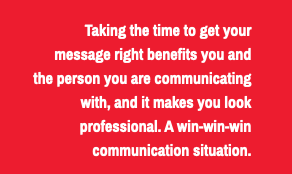The Right Message
By Jason White, Manager Strategic Initiatives
This quarter’s theme is doing business communications right. There are many ways to interrupt ‘right’ when it comes to communications, and we are going to explore a few.
The golden rule of treat others as you want to be treated doubly applies to communications. Being polite reduces miscommunication, especially in business emails.

Almost without exception, people do not take offence if you are polite when asking for something or following up on a sensitive issue. Being nice in your communications also means that if you make a mistake or your message is confusing, at least you were not mean about it. Your reader will be more understanding. It is never looks good to be full of righteous indignation only to find out, you are in the wrong.
Next, ask yourself – am I communicating using the right method. For example, will a text message be better than a phone call. Is my tone, tense, and vocabulary appropriate? Is my messaging clear? Is it suitable for a work environment? There are dozens of factors to consider when communicating, and for the most part, we do this unconsciously. However, for our audience to get the right message and to ensure we are business appropriate, we need to step back and take a moment to reflect on our communication. Before sharing memes and jokes with co- workers by email, for example, I always ask myself, would I send this to my mother. If it is not appropriate for my mother, it is not appropriate for work.

Finally, proofread your emails and do not assume your reader is going to understand the bigger picture. Get in the habit of checking your emails for grammar, spelling and style errors before hitting send.
We have all hit send too soon and realized there are typos after the fact. I hate that feeling. So, take the time
to send proofread emails. Similarly, make sure your message, email, text, or request is going to get the response or answer you are looking for. There is nothing more frustrating than sending a request by email and getting an ambiguous response.
For example, if I send an email to a supervisor saying “I’d like my break at 11am or 1pm”, I could get a response saying “OK”. Well, which is it – 11 or 1? Take the guess work out of the message for the reader and write something like “Please let me know if I can take my break at 11am or 1pm because I need to make a phone call.”
